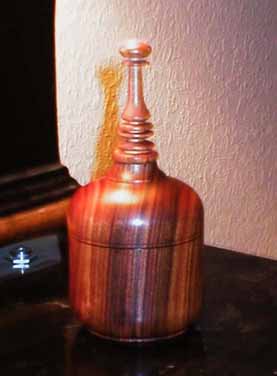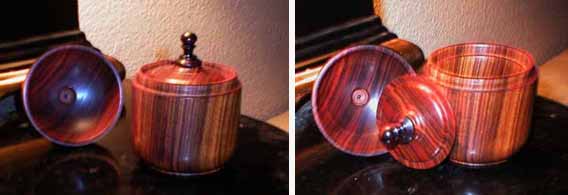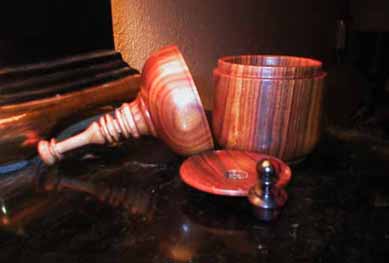How The Nice One Came to Be
When I start a woodworking project, I often have only a vague idea of where I'm going. To a large extent, the lathe is the most accomodating woodworking tool for this approach to making things- maybe because it's a fairly low risk activity. I don't use much wood, it allows for plenty of experimentation and I'm only out maybe an hour if things blow up in my face - figuratively or literally. OR - I have an adequate, sometimes really nice, piece to show for my time and effort. And because I can make something pretty nice in an hour and a half, or less, it's easy to make three, four or five nice things - before lunch - so I often do just that. Now if Practice Makes Perfect is true - which it seems to be - with all that practice, the second piece is better than the first, the third better than the second - and so on. Each piece can be a slight, or significant, variation of the previous piece - an evolution thing. It's impossible to do a series of a piece of furniture or even jewelry boxes - in a day. And, with the price of wood, let alone rosewood, the cost would be prohibitive. Furniture designs just can't evolve anywhere close to as quickly as a turned design can.
Evolution is a slick process because - every once in a while - there's a gene mutation. Sometimes it just changes the size or color of something. But then there's the one that starts a new branch on the Family Tree.
Such was the case with The Nice One.

And here's the New Branch Of The Turned Lidded Box Family Tree
Two more parts added to my turned lidded boxes repetoire.
(Two?)

Yes, TWO - the added interior lid and the handle to get it out .
The interior lid "clicks" into place and doesn't even think about moving even if you turn the piece upside down and shake it. It sound and feels nice when it clicks in place - a nicer sound than the "pop" as the outside lid is removed. Takes longer to sneak up on "pop" and "click" fits - but it almost screams "Patience, Precison - THIS Is A SPECIAL Piece!". What reinforces that point is that the grain of the interior lid line up near perfect with the grain of the box. With the interior lid in place, the bottom of this "box" looks like a solid piece of wood. Its handle tells you that, in fact, it isn't and encourages you to see what's inside the box. It piques one's curiosity, anticipating what's inside. It's a surprise, inside a surprise - the Nesting Russian Dolls thing. And - if there's actually something inside the box . . . !

( OK - I'm sure someone else already came up with the Two Lids idea - and it's probably demonstrated on a dozen turning tapes or DVDs and has probably been in another dozen turning books and articles - but I "discovered" it all on my own, never having seen it anywhere before. Could just be the "A million monkeys on a million wordprocessors - eventually - coming up with one or more of Shakespear's plays" thing)